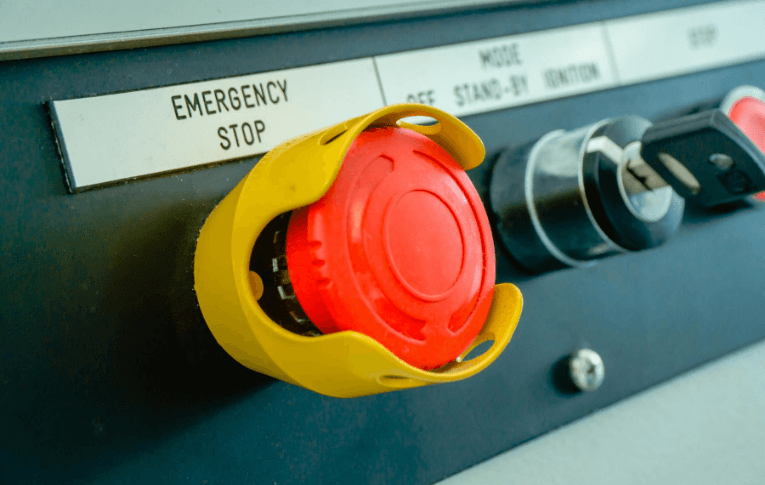If your business operates equipment or machinery of any size or type, then making sure your staff are fully trained in how to operate it is essential. Underestimating the true importance of equipment training could well be at your own peril — and that of others.
In October 2016, a malfunction on the Thunder River Rapids Ride at the Dreamworld amusement park on Australia’s Gold Coast resulted in the deaths of four people. The ensuing investigation into the tragedy uncovered several causes, including poor ride maintenance and unapproved modifications. The most significant cause was inadequate staff training on Dreamworld’s part.
Effective equipment training means giving your staff comprehensive guidelines around how to use and operate plant and equipment in your business. These guidelines must support your employees in safely completing necessary tasks as they deliver services to your customers.
“Comprehensive”, when we’re talking about equipment training, means your staff should know the following things at a minimum:
- what Personal Protective Equipment (PPE) they need to use and/or wear
- where equipment is located on the premises, and how it should be stored when it’s not being used
- what work tasks and processes involve using which pieces of equipment
- how to prepare equipment for use
- how to operate equipment, including any specific dos and don’ts to be aware of
- what maintenance procedures they should carry out on the equipment before, during and after its use
- how to shut down equipment fast if there’s an emergency
- what records they need to maintain for the equipment
- how to identify and report problems and defects.
Guidelines typically take the form of Policies, Procedures and Processes, like the documentation your staff access through Way We Do.
Why provide equipment training?
Apart from avoiding tragedies like the one that happened at Dreamworld, there are a raft of good business reasons to make sure your staff are fully trained up when using equipment at work.
1. Employee Education
Make sure you include equipment training as part of your induction program for new hires. Training your staff the right way from the very beginning raises your team’s overall competence, and lowers the risk of injury, breakage, or any other mishap that can hurt your business or your people. Offer regular refreshers to staff who may not have used a certain machine for some time, and to those who may be transferring across from another part of the business.
2. Cut off bad habits and address myths
Staff may have preconceived ideas about what a certain piece of equipment can do, or they may have picked up bad habits over time. Quell the myths and set new habits by building their factual knowledge through good equipment training. That knowledge should be about more than just operating the equipment. Teaching them about how to look after the equipment properly will help minimize issues that might slow them down. It will also minimize maintenance calls, and extend the asset’s life.
3. Improve your operator’s skills: Certification vs Competency
Certain industries require employees be certified or licensed to use specific equipment — for instance, the construction industry with heavy plant and equipment. However, a certificate does not always mean competence. While your staff may have core qualifications and licenses, that does not mean they will necessarily be familiar with the specific equipment you use and operate. Training all your new hires in how you manage your equipment — regardless of their existing qualifications — will ensure everyone has the same information and understanding from Day One.
4. Reduce equipment wear and tear
Properly trained staff know how to operate your equipment in the way it was intended, and the for the purpose it was designed. This not only cuts down on unnecessary wear and tear, but also protects any warranties or service agreements.
Not using equipment properly hurts your bottom line — through safety issues and audits; production delays and halts for repairs and maintenance; reduced capacity and production; and the flow-on effects to your customers.
5. Strict Chain of Responsibility (COR) adherence
The principle of Chain of Responsibility (COR) increases team members’ safety and their accountability to one another when they’re onsite. A slack chain of responsibility can result in tragedies like Dreamworld. A clearly outlined COR sets out each person’s duty for using the equipment safely.
Efficient equipment training
For your equipment training to be effective, it must be thorough. When you’re developing and delivering equipment training for your staff, be sure to consider the following elements.
1. Use readily available manufacturers’ resources
As well as Operating Manuals, some manufacturers provide training solutions for using their equipment. Leverage these resources whenever you buy a new piece of equipment — even if it’s just a photocopier. Heavy equipment manufacturer, Caterpillar, has a training solution called Caterpillar University that is solely dedicated to teaching people how to operate their equipment. The training includes hands-on, and classroom-based lessons.
You can include excerpts from Operating Manuals as content in Way We Do. You might choose excerpts of a troubleshooting process, or a routine maintenance check, which you can initiate automatically using schedules.
2. Appoint in-house experts
Identify one or two staff members as in-house experts on certain equipment, and make them responsible for training new employees, and supporting staff when they need additional help. Make sure your in-house experts work in areas where they regularly use that equipment. Check their training records, performance reviews, and use of procedures to ensure they’re the most competent and reliable person for the role, and provide any additional training they may need to take on the “expert” mantle.
In-house experts should also be responsible for mentoring subsequent generations of workers into the in-house expert role.
3. Streamline training based on competency
Depending on how in-depth your training program will be, you may want to break it down into separate competencies. You may then decide that each competency level can only use equipment to a certain extent. For them to carry out tasks beyond this, they will need to advance to a higher competency.
To be considered an expert, employees will need to advance through all the competency levels you have established.
4. Develop an internal training program
Creating an internal training program gives you the flexibility to tailor your delivery to the average level of literacy your staff have with your equipment. You can break your program down into two main areas: Basic, and Ongoing Skill Development.
Basic training should cover the foundational knowledge they need to do their job safely and effectively. Ongoing Skill Development can be a regular or continuous process of learning new skills, or improved processes, that can then feed into career advancement opportunities. An excellent example of how to create a training plan is How to create a training plan for medical equipment on Australia’s Open Learning platform.
What can Way We Do do to help with equipment training?
We’ve discovered some Way We Doers who use the platform to train their staff, as well as run their procedures and business operations, making use of their Way We Do online manuals. Here’s how you can do the same.
1. Access provisioning of your training materials. Just like you can create SOPs in Way We Do, you can also create your own training materials. All the content you create in your Way We Do online manual is your IP. The articles you create for your training program are only accessible to those users you give permission to.
2. Access to workflows for specialized work tasks. Creating your training program is just the beginning. You also need to provide the SOPs, procedures, and checklists that will support the training you’ve given your staff, using your online manual. Once you’ve made this available in Way We Do, it becomes the “Ultimate Source of Truth” for your business’s day-to-day operations.
3. Access to completion records. Similar to the workflows you’ve set up in your operations manual, you’ll still have records of completion retained in Way We Do. These could be entries for maintenance logs, risk assessments, safety audits, even training logs. If you haven’t already, set these up using Activated Checklists in Way We Do.
4. A means of enforcing safety standards. With your training program and supporting SOPs working side-by-side in Way We Do, you’ll be better able to enforce safety standards in your business. The reporting section in Way We Do gives you visibility of your team’s activities so you can see who is working to standard, and who may need further review or training.
5. Enhanced team collaboration. Way We Do also has tools your staff can use to collaborate with one another when they’re using your online manual, from assigning roles in specialized processes, to inviting team members to work with you on certain tasks.
6. Frequent assessments and reminders. Make use of the Activated Checklists to set up assessments for your staff once they’ve completed training. You can also use the Activated Checklist as an observational assessment, where you observe your staff member completing a process from start to finish. From there, you can determine if you’re satisfied with the level of competency, or if they need further training.
What’s in it for your business?
Implementing comprehensive equipment training for everyone on your staff may sound like a big undertaking of time and resources, but it really is worth it in the long run. These are just some of the benefits of investing in your team.
1. Cost savings. How your team operate your equipment has significant impacts on its total cost of ownership. Trained operators know when to let their managers know about alerts and reminders in the the machine’s preventive maintenance schedule, helping avoid unplanned downtime and more costly repairs.
2. Meet compliance needs. With comprehensive equipment training, you know your staff are trained up to regulatory standards. Carrying out regular equipment training with the help of your Way We Do account will keep your compliance reporting on track.
3. Access to performance reports. Staff who proactively apply what they learn to their daily work perform better. Track team performance, before and after training, using Way We Do.
4. Consistency in quality standards. Every organization has its own quality standards, whether they’re set internally, or externally through industry regulations. The advantage of using Way We Do is being able to document those standards into policies, procedures and checklists so that everyone strives for the same vision. Regular equipment training helps you maintain and even improve these standards as time goes on.
5. Better processes. A comprehensive training manual needs the right business processes in place to support it. Tailoring a training manual for your team is an excellent opportunity to identify areas you can improve in your processes, and address them throughout your business. Regular training also helps keep your business processes up to date, feeding into a philosophy of continuous improvement.
6. Better safety awareness, better maintenance, and better equipment care. Safety hazards are everywhere in the workplace, and when equipment and machinery are involved, those hazards become more pronounced. It’s imperative that your equipment training instills a strong awareness of safety in your staff. Good equipment training will mean your staff know how to use the right equipment, for the right job, and at the right time. Well-trained staff also take better care of equipment better, lengthening its useful life, and boosting your return on investment.
7. Opportunities for business certification. A solid training program and enforcement protocols can put your business in a positive light, both in your industry, and with your customers. It can offer your business the opportunity for quality and process certifications, which in turn can open doors to new business opportunities.
Next steps
We tend not to notice issues when things are working smoothly, and the value of good training can escape us as well. That is, until some costly mistake or mishap occurs. It may start as simply as one seemingly insignificant task being missed, or a piece of information being ignored or misunderstood. But the cumulative effects can be devastating.
The first step to creating real improvement is to change your organization’s cultural perception of equipment training. Here’s a step-by-step approach to help you plot your journey.
- Identify who your team experts are. Make use of subject matter experts you may already have in house, and take note of those who show a keen passion for proper equipment use.
- Research what manufacturer resources are available, both online and on site. Manufacturers like Caterpillar, Liebherr, and Volvo offer training resources for their customers. Depending on the manufacturer, you may find others who offer similar resources and services to help you develop your equipment training program.
- Address failures and compliance issues immediately. Don’t wait for something big to happen before you take actions. The costs of not taking immediate action can be beyond the business’s capacity to resolve — and that hurts everyone.
- Understand technology changes and how they affect your business. Technology changes fast, and machinery you bought 10 years ago won’t operate the same way as something that rolled off the production yesterday. Take the time to understand how these changes will impact how you operate, and make sure your staff understand the difference between operating older and newer versions of your machinery.
Implemented correctly, equipment training can be a critical success factor for your business. It can contribute to ongoing improvements in your business practices, reduce the risk of injury and breakdowns, and increase the working life of what can be very expensive machines. As the adage goes “an ounce of prevention beats a tonne of cure”, so never underestimate the power of good equipment training.





